Stress is an unavoidable part of modern life—work pressure, constant notifications, and daily responsibilities can leave you feeling overwhelmed. Over time, this stress can affect your sleep, mood, and overall health.
Thankfully, yoga offers a simple and effective way to reset. More than just stretching, yoga combines movement, breathing, and mindfulness to calm the nervous system and reduce stress hormones like cortisol.
In this guide, you’ll learn the most effective yoga poses to reduce stress, even if you’re a beginner. From gentle stretches to relaxing restorative yoga poses, these asanas will help you unwind, improve focus, and feel more grounded—anytime, anywhere.
Ready to feel calmer in just a few minutes a day? Let’s begin.
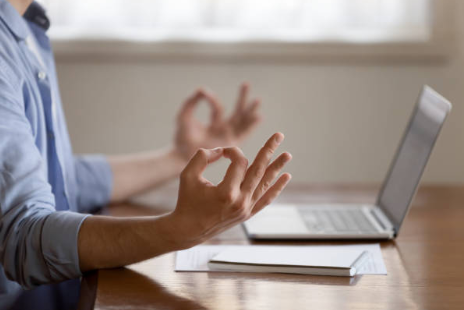
The Science Behind Yoga & Stress Relief
Yoga works by activating the parasympathetic nervous system—the body’s natural “rest and digest” state—which helps lower cortisol (the stress hormone), reduce heart rate, and calm the mind. Research shows that regular yoga practice can decrease anxiety, improve sleep, and enhance emotional resilience. Breath control (pranayama) and mindful movement increase vagal tone, which is linked to better stress regulation. Even just 10 minutes of gentle poses can shift brain chemistry, promoting feelings of peace and well-being. In short, yoga isn’t just relaxing—it’s scientifically proven to help your body and mind recover from daily stress.
The Main Sequence: Stress‑Reducing Yoga Poses
This yoga sequence is carefully designed to ease tension, calm the nervous system, and bring your mind and body into a state of relaxation. Each pose below includes step-by-step instructions, key benefits, and tips for getting the most out of your practice. Whether you’re a beginner or an experienced yogi, these poses can be practiced daily to help you manage stress naturally.
1. Child’s Pose (Balasana)
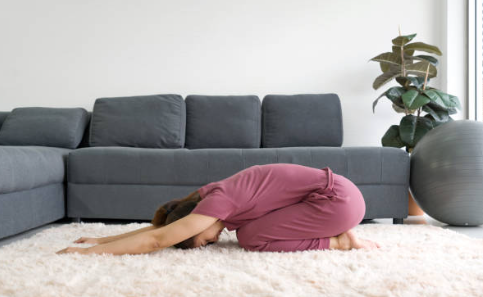
How to do it:
- Kneel on your mat with your big toes touching and knees spread apart.
- Sit your hips back onto your heels.
- Fold forward, resting your forehead on the mat.
- Extend your arms forward or keep them by your sides.
- Breathe deeply and hold for 1–3 minutes.
Benefits:
- Grounds the nervous system
- Gently stretches the spine and hips
- Promotes a sense of safety and calm
Tip:
Use a cushion or block under your forehead for added comfort.
2. Legs Up the Wall (Viparita Karani)
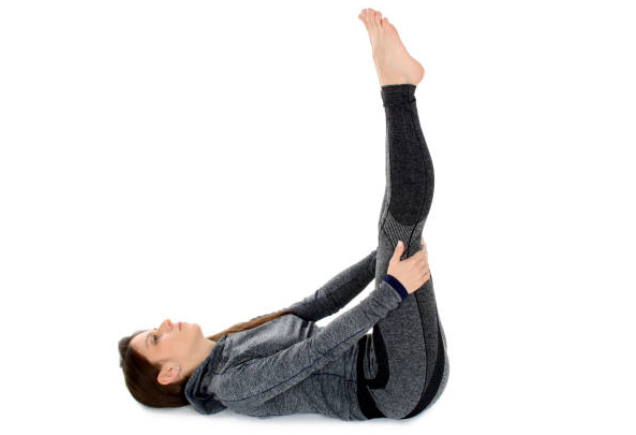
How to do it:
- Sit sideways next to a wall.
- Lie back and swing your legs up the wall.
- Adjust your hips close to the wall and relax your arms at your sides.
- Close your eyes and breathe slowly.
- Hold for 5–15 minutes.
Benefits:
- Reverses blood flow and reduces swelling in legs
- Calms the nervous system
- Helps reduce anxiety and fatigue
Tip:
Place a folded blanket under your hips for gentle support.
3. Standing Forward Fold (Uttanasana)
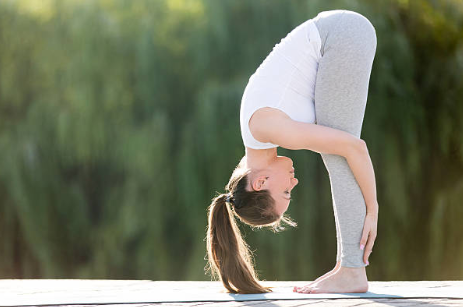
How to do it:
- Stand with feet hip-width apart.
- Inhale, lengthen the spine.
- Exhale, hinge from the hips and fold forward.
- Let your head and arms hang.
- Bend your knees slightly if needed. Hold for 1–2 minutes.
Benefits:
- Relieves tension in the back, neck, and shoulders
- Encourages inward focus and calm
- Stimulates the parasympathetic nervous system
Tip:
Sway gently side to side to release additional tension.
4. Reclining Bound Angle Pose (Supta Baddha Konasana)
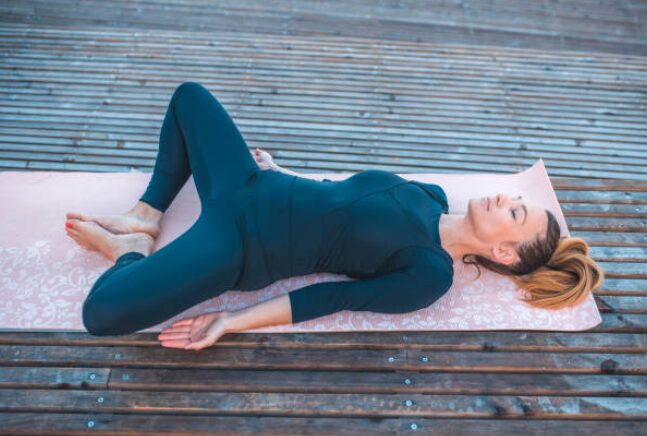
How to do it:
- Lie on your back.
- Bring the soles of your feet together and let your knees fall open.
- Place pillows or blocks under your knees for support.
- Rest your hands on your belly or at your sides.
- Close your eyes and breathe deeply for 3–5 minutes.
Benefits:
- Opens the hips and chest
- Encourages deep relaxation
- Balances emotions
Tip:
Use a bolster under your spine for additional support.
5. Cat-Cow Pose (Marjaryasana–Bitilasana)
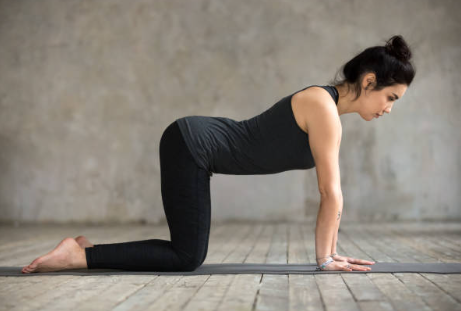
How to do it:
- Start on hands and knees in tabletop position.
- Inhale, arch your back (cow), lift chest and tailbone.
- Exhale, round your spine (cat), tuck chin to chest.
- Repeat slowly for 1–2 minutes.
Benefits:
- Increases spinal flexibility
- Releases tension in the back and neck
- Syncs movement with breath to calm the mind
Tip:
Close your eyes to tune into your body’s rhythm.
6. Supine Spinal Twist (Jathara Parivartanasana)
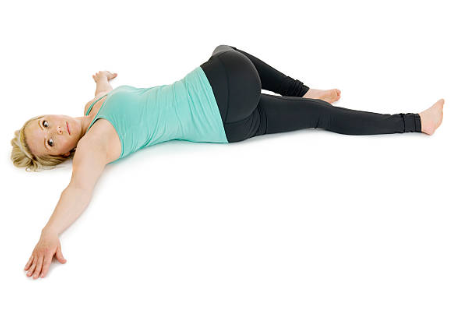
How to do it:
- Lie on your back with legs extended.
- Draw right knee into chest.
- Cross it over the body to the left, allowing it to rest on the floor.
- Extend right arm out and gaze to the right.
- Hold for 1–2 minutes and repeat on the other side.
Benefits:
- Gently massages abdominal organs
- Relieves spinal tension
- Balances the nervous system
Tip:
Use a pillow under the knee if it doesn’t reach the floor.
7. Corpse Pose (Savasana)
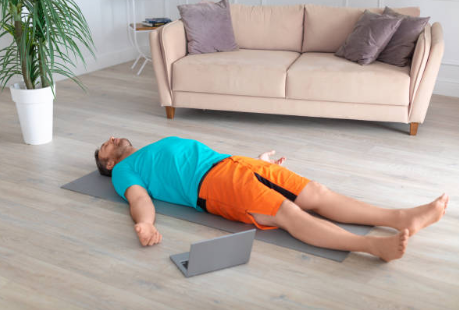
How to do it:
- Lie flat on your back with arms relaxed by your sides.
- Let your feet fall open naturally.
- Close your eyes and take slow, deep breaths.
- Stay in this pose for 5–10 minutes.
Benefits:
- Promotes deep rest and rejuvenation
- Helps integrate the benefits of the practice
- Reduces stress and anxiety levels
Tip:
Use an eye pillow or blanket for added comfort.
Stress-Relieving Yoga Routine Table
| Time Available | Recommended Poses | Duration | Goal |
|---|---|---|---|
| 10 Minutes | Child’s Pose, Cat-Cow, Savasana | 3–4 min each | Quick tension release |
| 15 Minutes | Legs Up the Wall, Supine Twist, Savasana | 5 min each | Relax body & calm nervous system |
| 20 Minutes | Forward Fold, Reclining Bound Angle, Cat-Cow, Savasana | 4–6 min per pose | Emotional balance & breath focus |
| 30 Minutes | Full Sequence (7 poses) | 3–5 min each | Deep relaxation & stress reset |
| Optional Add-On | Hero Pose, Bridge, Easy Pose w/ breathwork | 3–5 min each | Enhance focus & meditative calm |
Optional Add-On Poses
Hero Pose (Virasana)
- Encourages meditative stillness
- Grounds energy and promotes focus
Bridge Pose (Setu Bandhasana)
- Opens the chest and shoulders
- Calms the brain and reduces mild anxiety and depression
Happy Baby Pose (Ananda Balasana)
- Loosens tension in hips and lower back
- Invites playfulness and lightness
Easy Pose (Sukhasana) with Breathwork
- Sit cross-legged comfortably
- Inhale for 4 counts, exhale for 6 counts
- Regulates breath and quiets mental chatter
Final Note
You don’t need an hour-long class to experience the benefits of yoga. Practicing just a few of these stress-relieving yoga poses daily—whether in the morning, after work, or before bed—can help restore calm, clarity, and energy. Yoga is not just movement; it’s medicine for the modern mind.
Be consistent, breathe deeply, and allow the poses to bring you back to balance.
Breathing Techniques & Mindful Practices
Incorporating breathwork and mindfulness into your yoga routine helps calm the nervous system and reduce stress more effectively.
1. Box Breathing (4-4-4-4)
Inhale 4 → Hold 4 → Exhale 4 → Hold 4
Benefits:
Calms the mind, improves focus.
2. Extended Exhale (4-6 Breathing)
Inhale for 4, exhale for 6
Benefits:
Reduces anxiety, supports relaxation.
3. Alternate Nostril Breathing
Breathe in left, out right → in right, out left
Benefits:
Balances energy, clears the mind.
4. Body Scan Meditation
Mentally scan body from head to toe
Benefits:
Relieves tension, improves awareness.
5. Affirmations & Visualization
Repeat calming phrases or visualize peaceful scenes
Benefits:
Encourages emotional calm and positivity.
Final Thought
Your breath is your most powerful tool for stress relief—always available, always free. When paired with mindful yoga, it becomes a gateway to calm, clarity, and emotional balance. Start small, stay consistent, and trust the process. Even a few mindful breaths each day can create lasting peace in both body and mind.
Frequently Asked Questions
1. How often should I practice yoga for stress relief?
Daily practice, even just 10–15 minutes, can significantly reduce stress over time.
2. Can beginners do these yoga poses?
Yes! All poses listed are beginner-friendly and include modifications for comfort.
3. What is the best time to do stress-relief yoga?
Evening or before bed works well, but any time that fits your schedule is beneficial.
4. Do I need special equipment?
A yoga mat is helpful. Blocks, bolsters, or pillows can enhance comfort, but aren’t required.
5. How long should I hold each pose?
Hold each pose for 1–5 minutes, depending on your comfort level and time available.
6. Is breathing important during yoga for stress?
Absolutely. Slow, deep breathing activates the parasympathetic nervous system and enhances relaxation.
7. Can yoga really reduce anxiety and depression?
Yes, research shows that regular yoga practice helps regulate mood, reduce cortisol, and improve overall mental health.
Conclusion
Stress is an unavoidable part of life, but how we respond to it is in our control. By practicing these simple yet powerful yoga poses regularly, you can create a safe space for your mind and body to relax, reset, and recharge. Whether you have 10 minutes or 30, this sequence supports your emotional well-being, calms the nervous system, and builds inner resilience.
Remember: Consistency matters more than intensity. Just a few mindful minutes a day can make a big difference.
Start where you are, breathe deeply—and let your yoga mat become your place of peace.
More Articles About the Brain Health
Ultimate List of Words for Memory Test
How to Focus Better in School: Effective Study Strategies for Students
Left and Right Brain Exercises to Boost Creativity, Focus & Performance
How to Concentrate Better While Studying
Yoga Poses to Reduce Stress: Simple Asanas for Calm & Clarity



